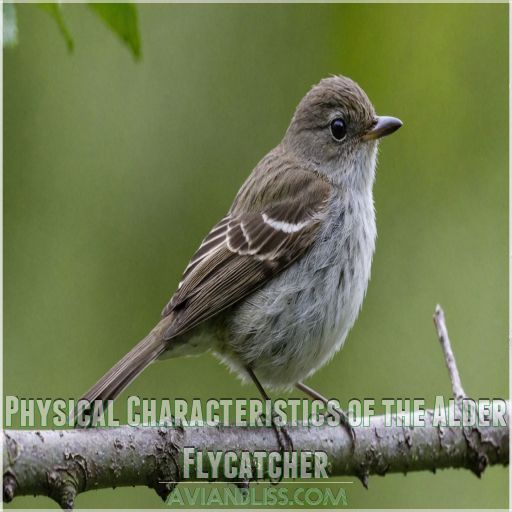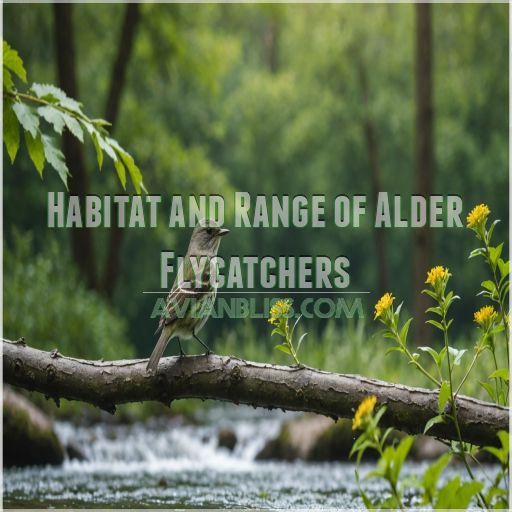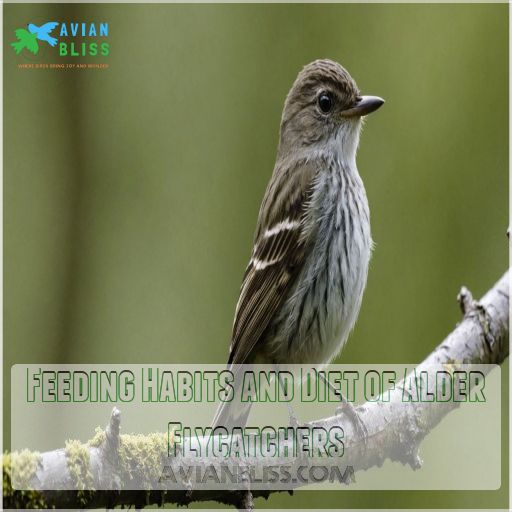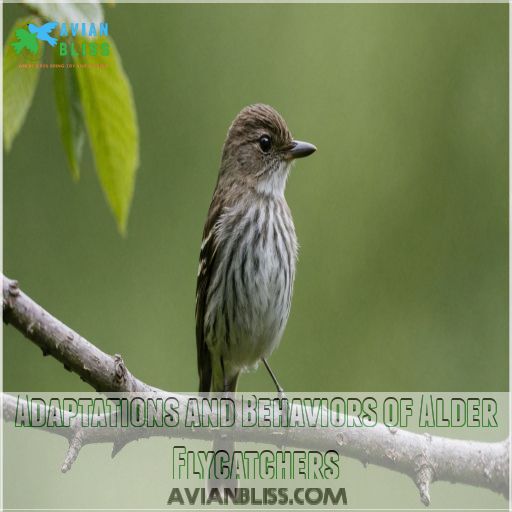This site is supported by our readers. We may earn a commission, at no cost to you, if you purchase through links.

They’re master insect-catchers, darting from perches to snag flying bugs mid-air.
Come breeding season, they build cozy nests in shrubs near water, laying 3-4 speckled eggs.
These feathered frequent flyers migrate from Alaska to Newfoundland, preferring higher altitudes in the Appalachians.
Their unique vocalizations aren’t just for show – they’ve evolved to cut through noisy wetlands and attract mates.
But there’s more to these pint-sized predators than meets the eye or ear.
Table Of Contents
- Key Takeaways
- Physical Characteristics of the Alder Flycatcher
- Habitat and Range of Alder Flycatchers
- Vocalizations and Songs of the Alder Flycatcher
- Nesting Behavior and Reproduction of Alder Flycatchers
- Feeding Habits and Diet of Alder Flycatchers
- Conservation Status and Population Trends
- Taxonomic History and Species Classification
- Adaptations and Behaviors of Alder Flycatchers
- Frequently Asked Questions (FAQs)
- Where does the Alder Flycatcher live?
- How do you identify an Alder Flycatcher?
- What is the difference between alder and least flycatchers?
- What are some interesting facts about Alder Flycatchers?
- How do Alder Flycatchers interact with other bird species?
- What are common predators of Alder Flycatchers?
- How do Alder Flycatchers cope with extreme weather?
- Whats the average lifespan of an Alder Flycatcher?
- How do Alder Flycatchers migrate long distances?
- Conclusion
Key Takeaways
- You’ll spot these feathered dynamos by their raspy "free-beer!" call, but don’t expect a cold one – it’s just nature’s way of saying "hello" in alder flycatcher-speak.
- These pint-sized predators are masters of aerial acrobatics, snatching insects mid-flight with the precision of tiny, feathered fighter pilots.
- Don’t let their small size fool you – alder flycatchers are tough cookies, adapting to climate change by tweaking their nesting habits and migration patterns, much like the woodpeckers in New Hampshire have done
.
- You might mistake them for their willow flycatcher cousins, but their unique vocalizations and preference for wet thickets set them apart – it’s like nature’s own game of "spot the difference.
Physical Characteristics of the Alder Flycatcher
You’ll find the Alder Flycatcher a pint-sized powerhouse, measuring just 5.5 to 6.3 inches long with a wingspan that barely reaches 8.3 inches.
Despite its small stature, this olive-brown bird packs a punch with its bold white eyering and distinctive "free beer" song that’ll have you doing a double-take in the forest, with its bold white eyering.
Size and Weight
You might think these little feathered friends are lightweights, but Alder Flycatchers pack a punch in a tiny package.
They’re the Goldilocks of the bird world, measuring just right at 5.12-6.69 inches long with a wingspan of 8.3-9.4 inches.
Tipping the scales at a mere 0.47 ounces , they’re like a handful of feathers.
Don’t let their size fool you, though – these pint-sized powerhouses are masters of aerial acrobatics!
Plumage Coloration
Now, let’s paint a picture of this pint-sized powerhouse’s plumage.
The Alder Flycatcher (Empidonax alnorum) sports a grayish-olive coat that’d make any fashionista jealous . It’s like they’ve got a dusky vest on, perfect for those woodland soirées.
Their wardrobe isn’t flashy, but it’s got style:
- Olive-toned upperparts
- Dusky breast coloration
- Subtle white wing bars
- Age-related plumage shifts
This feathered friend’s attire serves a purpose beyond looking fly – it’s camouflage at its finest!
Distinctive Features
While its plumage may not turn heads, the Alder Flycatcher’s got some nifty features that’ll make you do a double-take.
This tyrant flycatcher sports a narrow, whitish eyering that’s often indistinct – it’s like nature’s version of subtle eyeliner.
But what really sets this aerial insectivore apart are its bold wingbars, standing out like runway lights on its olive-green wings.
These distinctive markings help this little bird navigate its wetland habitat with style.
Comparison With Similar Species
Those distinctive features we just explored? They’re your secret weapon in the bird-watching world. Let’s face it, the Alder Flycatcher’s like a doppelganger in a feathered soap opera.
- Size matters: It’s a smidge larger than the Least Flycatcher
- Eyering envy: Less bold than its Least cousin
- Habitat hints: Loves those alder thickets
- Vocal virtuoso: That harsh "fee-bee-oo" is your golden ticket
Habitat and Range of Alder Flycatchers
You’ll find Alder Flycatchers nesting in shrubby, moist habitats across Canada and Alaska, often near streams or woodland edges.
These tiny travelers spend their summers in the north, then jet off to warmer climes for winter, covering a range that’ll make you wish you’d wings.
They are also known as tiny travelers spending their time in different locations.
Preferred Breeding Environments
You might think these little brown birds are boring, but wait ’til you see where they hang out!
Alder Flycatchers are the life of the party in wet thickets across northern North America. They’re not picky – bogs, beaver ponds, or streamside shrubs will do just fine for their breeding grounds .
| Habitat Type | Key Features | Nest Location |
|---|---|---|
| Alder swamps | Dense foliage | Low in shrubs |
| Willow thickets | Near water | 2-6 feet up |
| Second-growth forests | Open understory | Vertical forks |
| Riparian areas | Insect-rich | Hidden in leaves |
| Bog edges | Wet soil | Built with bark strips |
These feathered freedom-seekers aren’t afraid to get their feet wet for the perfect home!
Geographic Distribution
The Alder Flycatcher‘s range is like a cozy northern blanket, stretching from Alaska to Newfoundland . You’ll find these feathered free-beer enthusiasts setting up shop in wet thickets across northern North America. They’re the high-altitude crowd of the Appalachians, preferring loftier digs than their Willow Flycatcher cousins. It’s like they’ve got a taste for the crisp mountain air!
- Range shifts: Climate change’s wild card in bird distribution
- Habitat overlap: Nature’s melting pot of species interaction
- Breeding grounds: Where love nests and insect buffets collide
- Population density: The bird world’s real estate market
- Boreal forest connection: Canada’s 63% claim to Alder fame
Seasonal Migration Patterns
As summer fades, our feathered friends pack their tiny suitcases for an epic journey south.
You’ll spot these pint-sized adventurers taking off from Alaska to Newfoundland. They’re not just winging it – Alder Flycatchers follow specific migration routes, making pit stops at cozy stopover locations.
By August, they’re jetting off to tropical wintering grounds, swapping their "free beer" calls for piña coladas.
Talk about a well-deserved vacay!
Specific Nesting Locations
Now that our feathered friends have completed their journey, let’s peek into their cozy nooks.
Alder Flycatchers are picky homemakers, opting for wet thickets and beaver ponds. You’ll find their nests tucked low in deciduous shrubs, usually about 2 feet. They’re not afraid to get their feet wet, often building near water.
These resourceful birds use grass, bark strips, and plant down to craft their humble abodes, often made of grass, bark strips, and plant down.
Vocalizations and Songs of the Alder Flycatcher
You’ll be amazed by the Alder Flycatcher’s unique vocal repertoire.
The "free beer" song that’ll make you do a double-take is one of its most famous attributes.
From its distinctive alarm calls to its subtle seasonal variations, this tiny songbird’s vocalizations offer a fascinating window into its behavior and ecology.
Distinctive Free Beer Song
You’ve just stumbled upon the Alder Flycatcher‘s natural habitat, but hold onto your hat. This tiny songbird’s about to rock your world with its distinctive call. Ever heard someone yell "free beer" in the woods? That’s our feathered friend’s claim to fame.
Let’s break down this avian vocalist’s greatest hits:
- Song origin: Evolved to stand out in noisy wetlands
- Bird mimicry: Sounds eerily like a human phrase
- Song variation: Can blur into "fee-beer" in some renditions
- Song function: Marks territory and attracts mates
Alarm and Contact Calls
The Alder Flycatcher’s repertoire goes beyond its catchy "free beer" tune.
Listen closely, and you’ll catch their emphatic "pit" or "pip" alarm calls . These sharp notes serve as a warning system, keeping the flock on its toes.
Unlike their Willow cousins’ "whit" call, Alders have mastered their own unique vocal fingerprint .
It’s like they’re speaking in code, a secret language that binds their feathered community together with their own secret "whit" call.
Seasonal Variations in Vocalizations
Songbirds, like our tiny friend the Alder Flycatcher, don’t sing the same tune year-round. You’ll notice their vocalization changes as seasons shift, reflecting their journey through life’s rhythms.
Let’s explore how these feathered crooners adjust their playlist:
- Breeding season bonanza: Loud "fee-bee-o" calls echo through the air
- Migration melodies: Softer chirps guide their long-distance travels
- Winter silence: They save their vocal cords for warmer days ahead
Isn’t it fascinating how these pint-sized performers adapt their symphony to nature’s grand orchestra?
Comparison With Willow Flycatcher Songs
Now, let’s tune our ears to the subtle differences between these feathered vocalists.
While Alder Flycatchers belt out a rolling "ree-bee-o," their doppelgängers, the Willow Flycatchers, opt for a sneezy "fitz-bew" .
This song variation is your golden ticket for bird identification, especially where their ranges overlap, like the Black-capped Chickadee’s "wee-woo" call. like the Black-capped Chickadee’s "wee-woo" call
.
It’s like nature’s own karaoke battle – no mimicry here, just pure, unadulterated flycatcher melodies that’ll have you humming along in no time!
Nesting Behavior and Reproduction of Alder Flycatchers
You’re about to peek into the private lives of Alder Flycatchers.
Those tiny architects of the bird world have impressive skills.
From their intricate nest-building skills to their dedicated parenting.
You’ll see why these little songsters are the ultimate multitaskers of the forest.
Nest Construction Techniques
After serenading you with their "free beer" song, Alder Flycatchers get down to business.
You’ll find these crafty architects building their homes low in dense, shrubby bushes.
Their nest-building skills are as impressive as their vocal talents:
- Gathering coarse grass for a bulky cup shape
- Adding streamers of moss for flair
- Incorporating cattail for extra insulation
- Finishing with grass hanging from the rim
It’s like they’re decorating a tiny, avian treehouse – functional and stylish!
Breeding Season Timeline
With their cozy nests ready, Alder Flycatchers kick off their breeding season like clockwork.
You’ll spot these feathered friends setting up shop in wet thickets, similar to those preferred by the Northern Cardinal, from mid-May to early June, typically when identifying Indiana birds becomes a fun and rewarding activity
. It’s a real estate frenzy as they scout for prime locations, usually low in dense, shrubby bushes.
Once they’ve found their dream home, these tiny architects get busy preparing for their future family, working hard to ready their cozy nests and get everything just right for the start of their breeding season.
Clutch Size and Incubation Period
These tiny architects of the avian world lay a modest clutch of 3-4 eggs.
You’ll find their nests cradling creamy or buff eggs, sometimes adorned with dark speckles – nature’s own Easter eggs!
The incubation period lasts 11-14 days, during which parents take turns warming their future free-beer singers.
Egg variation and incubation shifts play important roles in hatching success, ensuring the next generation of these charming flycatchers takes flight.
Parental Care and Fledgling Behavior
From the moment tiny Alder Flycatcher nestlings hatch, their parents become superheroes of the bird world.
You’ll see these devoted moms and dads tirelessly defending their nests and feeding their growing chicks.
As the nestlings develop, they transform from helpless fluff balls to feathered adventurers.
Soon, these fledglings venture out, learning to catch insects on the wing while their parents continue to provide "free meals" until they achieve full independence.
Feeding Habits and Diet of Alder Flycatchers
You’ll be amazed by the Alder Flycatcher’s eating habits, which are as lively as its "free beer" song.
These tiny insectivores gobble up an impressive variety of flying bugs, using clever aerial acrobatics to snag their meals mid-flight.
Primary Insect Prey Species
You’ve just witnessed the Alder Flycatcher‘s nesting miracle. Now, let’s talk grub!
These tiny feathered friends have quite the appetite for insects. Their menu includes:
- Wasps and beetles
- Flies and butterflies
- Caterpillars and grasshoppers
Talk about pest control benefits! You’ll find these flycatchers munching on a buffet of bugs, with seasonal prey shifts keeping things interesting.
It’s like they’re nature’s own little exterminators, keeping your backyard bug-free while singing their "free beer" tune!
Foraging Techniques
Aerial acrobats of the forest, Alder Flycatchers are masters of the "sally-and-hover" foraging technique.
You’ll spot these nimble birds darting from their perches to snatch insects mid-flight. They’re not picky eaters, gobbling up whatever’s on the wing.
With keen eyesight and lightning-fast reflexes, they’ll zip through branches, executing hairpin turns to capture elusive prey.
It’s like watching a tiny, feathered fighter pilot on a mission to keep the insect population in check.
Seasonal Dietary Variations
Throughout the year, your tiny feathered friend, the Alder Flycatcher, plays a game of dietary musical chairs. As seasons shift, so does their menu.
In spring and summer, they’re all about the bug buffet, feasting on flying insects when they’re abundant.
But come fall, they’re not above switching things up. Like a picky eater trying new foods, they’ll adapt their diet based on what’s available during migration and in their winter homes.
Impact on Local Ecosystems
These tiny insect-munching machines play a key role in food web dynamics.
As natural pest controllers, Alder Flycatchers keep insect populations in check, helping maintain ecological balance.
They’re like nature’s own extermination crew! By chowing down on flying bugs, they’re not just filling their bellies—they’re shaping predator-prey relationships and boosting biodiversity.
It’s a win-win: you get fewer pesky insects, and local ecosystems thrive. Talk about punching above their weight class.
Conservation Status and Population Trends
You might be surprised to learn that the Alder Flycatcher’s population has been on a rollercoaster ride, with numbers rising in the U.S. but dropping in Canada between 1966 and 2014.
Despite this mixed bag, these plucky little birds still boast a global breeding population of about 120 million, showing they’re not ready to give up their "free beer" calls just yet.
Current Population Estimates
While you’re out bird-watching, you might spot one of the 120 million Alder Flycatchers zipping around.
That’s right, these little "free beer" singers are quite numerous!
But don’t get too comfy – their population’s on a downward slope. If this keeps up, we could see half as many by 2082.
It’s like they’re playing a high-stakes game of musical chairs with their habitats.
Threats to Alder Flycatcher Habitats
You’d be surprised how often our feathered friends face a tough time out there.
The Alder Flycatcher’s cozy wetland homes are under siege, and it’s not just one boogeyman to blame.
Let’s break it down:
- Habitat loss: Wetlands are disappearing faster than you can say "free beer"
- Climate change: Shifting weather patterns are messing with their breeding grounds
- Pesticide use: These chemicals are zapping their insect buffet
It’s like their favorite hangout spots are vanishing before their eyes.
Conservation Efforts and Protected Areas
To combat the threats to Alder Flycatcher habitats, conservation efforts are underway.
You can get involved through citizen science projects, like the Breeding Bird Survey (Source), which help monitor population trends. Protected areas, such as national parks and wildlife refuges, also play a key role in safeguarding habitats.
| Conservation Effort | Impact | Location |
|---|---|---|
| Habitat restoration | Restores degraded habitats | National parks, wildlife refuges |
| Citizen science projects | Monitors population trends | Breeding Bird Survey |
| Conservation partnerships | Collaborates with landowners | Private-public partnerships |
| Climate change research | Studies climate change effects | Research institutions |
| Protected areas | Safeguards habitats | National parks, wildlife refuges |
Future Population Projections
Looking ahead, our feathered friend’s future is a bit of a rollercoaster ride. You’ll want to keep an eye on these key factors:
- Habitat loss: Shrinking wetlands spell trouble
- Climate change: Warmer temps could shift breeding grounds
- Conservation efforts: Your actions can make a difference
- Breeding success: It’s all about the next generation
If current trends continue, the Alder Flycatcher might lose half its population by 2082. But don’t lose hope! With your help, we can turn the tide for these plucky "free beer" singers.
Taxonomic History and Species Classification
You might think you’re looking at a Willow Flycatcher, but hold your horses – it’s the Alder Flycatcher’s doppelganger!
These two birds were once lumped together as Traill’s Flycatcher until scientists realized they were dealing with a classic case of avian identity crisis.
Historical Classification as Traill’s Flycatcher
Ever wondered about the identity crisis of our little feathered friend? The Alder Flycatcher‘s family tree has more twists than a soap opera.
Once lumped together with its cousin as Traill’s Flycatcher, this tiny songbird’s been through the taxonomic wringer. Let’s break down this avian drama:
| Year | Event | Impact |
|---|---|---|
| 1973 | AOU split | Two species emerge |
| 1980s | Vocal studies | Song differences noted |
| 2000s | DNA analysis | Genetic distinctions confirmed |
Talk about a bird’s eye view of historical confusion!
Genetic Studies and Species Separation
You’ve heard of Traill’s Flycatcher, but hold onto your binoculars. Genetic studies have shaken up the bird world like a feathery earthquake, revealing surprising relationships among species, including the ash-throated flycatcher’s habitat and range.
Scientists, armed with DNA and a molecular clock, have unraveled the Alder Flycatcher’s true identity. Through species delimitation and phylogenetic analysis, they’ve discovered it’s not just another pretty face in the crowd, with characteristics like distinctive calls and foraging behaviors setting them apart.
These tiny songbirds have been hiding their uniqueness in plain sight, with taxonomic implications that’ll make your head spin.
Relationship to Other Empidonax Flycatchers
From the branch of Empidonax flycatchers, the Alder Flycatcher stands out as a master of disguise. You’d swear it’s playing a game of "spot the difference" with its cousins!
- Virtually identical size (14-15 cm) to relatives
- Eerily similar coloration to other Empidonax species
- Songs that’ll make even veteran birders scratch their heads
- Genetic closeness that’s tighter than a flock in flight
Telling them apart? It’s like trying to find a needle in a haystack of feathers!
Subspecies Considerations
Two little birds, once thought to be the same, now stand apart.
The Alder and Willow Flycatchers, previously lumped together, showcase nature’s knack for surprise .
Let’s take a closer look at their tale of identity:
| Aspect | Alder Flycatcher | Willow Flycatcher |
|---|---|---|
| Voice | Distinctive | Similar, yet unique |
| Range | More northern | More southern |
| Habitat | Alders and birches | Willows and shrubs |
These feathered twins remind us that genetic diversity isn’t always obvious.
Their story’s still unfolding, with future research promising more twists in this avian soap opera.
Adaptations and Behaviors of Alder Flycatchers
You’ll be amazed by the Alder Flycatcher’s aerial acrobatics as it zips through the air, snatching insects mid-flight with incredible precision.
These tiny songbirds have fine-tuned their behaviors to thrive in their shrubby habitats, from their unique "free beer" call to their clever adaptations for changing environments, showcasing their remarkable aerial acrobatics.
Flight Patterns and Aerial Maneuvers
Watch closely as the Alder Flycatcher takes flight!
These tiny acrobats have mastered the art of aerial maneuvers.
You’ll see them darting from perches, executing sharp turns, and hovering like mini-helicopters to snatch insects mid-air.
Their wing morphology allows for quick, agile movements, perfect for their hunting strategy.
During migration, they’ll cover impressive distances, showcasing endurance that’d make any long-distance runner jealous.
It’s like watching nature’s own air show!
Territorial Behaviors
You’ve seen the Alder Flycatcher’s aerial acrobatics, now let’s talk turf wars.
These little fighters punch above their weight in terms of territorial behaviors. They’ll fluff up their feathers, extend their wings, and flick their tails to show they mean business (Source).
Their iconic "free beer" song isn’t just for fun – it’s a powerful tool for staking their claim and warning off intruders.
Talk about a pint-sized powerhouse!
Interspecific Interactions
Beyond their territorial squabbles, Alder Flycatchers are social butterflies in the avian world.
They’re not just chirping "free beer" for fun – it’s a complex game of interspecies charades. These tiny songbirds engage in fierce competition with other flycatchers for prime bug-catching spots.
But it’s not all dog-eat-dog out there. They’ve been known to team up with other bird species, forming a feathered neighborhood watch against predators.
Responses to Environmental Changes
In the face of environmental upheaval, our feathered friend the Alder Flycatcher is rolling with the punches. You’ll be amazed at how this tiny songbird adapts to climate change impacts and habitat loss.
They’re tweaking their nesting habits, adjusting their diet, and even shifting their migration patterns to keep up with the times (Source).
- A bird’s-eye view of resilience in action
- Nature’s own climate change warriors
- Tiny trailblazers in a changing world
- Winged hope for our fragile ecosystems
Frequently Asked Questions (FAQs)
Where does the Alder Flycatcher live?
Look for these feathered friends in wet thickets across northern North America.
They’re at home in open settings like bogs and beaver ponds, where they perch high and snatch insects mid-air.
Their range stretches from Alaska to Newfoundland, a space that covers a wide geographic area.
They’re also likely to be found in other areas with open settings.
How do you identify an Alder Flycatcher?
Telegraphing its presence, this feathered friend’s raspy "free-beer!" call is your best bet.
Visually, it’s tricky – olive-green plumage, bold wingbars, and an indistinct eye ring.
Look for it perched high in wet thickets, ready to snag insects.
What is the difference between alder and least flycatchers?
Spot the difference between these feathered doppelgangers!
Least Flycatchers sport a bold white eyering and shorter wings, while Alders have a weaker eyering and longer primaries.
Least’s "che-bek" call is shorter and more explosive than Alder’s "fee-bee-o" song.
What are some interesting facts about Alder Flycatchers?
These feathered virtuosos sing a raspy "free-beer!" call.
You’ll find them in wet thickets, catching insects mid-air. They’re masters of disguise, nearly identical to Willow Flycatchers.
Their nests dangle with mossy streamers, like nature’s wind chimes.
How do Alder Flycatchers interact with other bird species?
Birds in the boreal forest often interact in complex ways.
You’ll find Alder Flycatchers sharing foraging areas with thrushes, warblers, and sparrows.
They’ve been observed using exploration wells as communal feeding grounds, adapting to human-altered landscapes.
What are common predators of Alder Flycatchers?
Hawks swoop, snakes slither, and mammals prowl – all eyeing these feathered morsels.
You’ll find predators lurking in every nook of their habitat.
From the air to the ground, Alder Flycatchers must stay alert to survive.
How do Alder Flycatchers cope with extreme weather?
Resilient little birds adapt to weather extremes by seeking shelter in dense thickets.
You’ll find them huddling together for warmth or flitting to cooler spots during heatwaves.
Their genetic makeup evolves over time, helping them roll with nature’s punches.
Whats the average lifespan of an Alder Flycatcher?
You’d be amazed how these tiny marvels defy time!
While specific data on Alder Flycatchers is scarce, similar species like the Least Flycatcher live about 5 years.
Their resilience in harsh conditions contributes to their survival.
How do Alder Flycatchers migrate long distances?
These tiny travelers set out on epic journeys, suspending their molts for the trip.
They fly at night, using stars and landmarks to navigate.
During daylight pit stops, they refuel on insects to keep their wings buzzing, especially to sustain their energy for the next segment of their epic journeys.
Conclusion
Ironically, the tiny alder flycatcher’s "free beer" call won’t land you a cold one, but it might just spark a lifelong interest in birding.
These pint-sized predators pack a punch in the insect-catching world, proving that size isn’t everything.
As you explore wetlands and thickets, keep your ears peeled for their distinctive song. Who knows? You might find yourself hooked on spotting these charismatic little birds.
So next time you’re out in nature, remember: the alder flycatcher is waiting to say cheers!











